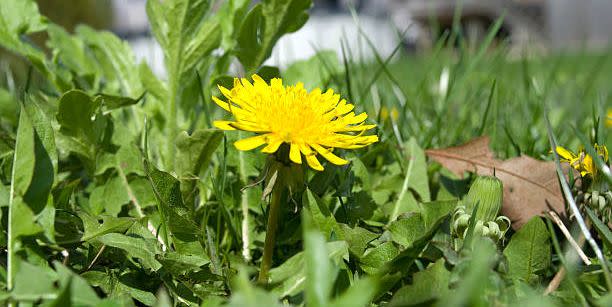A Step-by-Step Guide to Getting Rid of Dandelions

"Hearst Magazines and Yahoo may earn commission or revenue on some items through these links."
Although dandelions are the perfect daydreaming companion as far as flowers go (sorry, daisies!), in real life, these intruders are a nightmare to get rid of once they pop up on your lawn. Dandelions are perennial weeds, and they come back every year. They will take over your lawn if you don't treat them. So, unless you want a lawn full of dandelions, you're forced to deal with them sooner vs. later. We’ll teach you three easy steps to kill dandelions for good and how to eliminate them chemical free. You’ll have your dandelion problem under control in no time. Then you can return to doing what you enjoy the most, entertaining and having outdoor soirees with friends.
How to Prevent Dandelions
Your first defense against dandelions (or any weed) is to make sure you have a nice, thick, healthy lawn. That means don't mow too short or too often because you'll invite weed seeds to sprout in scalped areas. Know the proper mowing height for your grass; if you're not sure what you have, your local university coop extension service can help you identify the species in your yard.
What to Do If Dandelions Have Already Sprouted on Your Lawn
If you only have a few here and there, it's totally fine to dig them up by hand. Make sure to get the root (or as much of them as possible). Get them before they go to seed or you'll just be dealing with thousands more seeds.
You also can treat them with any type of three-way herbicide (it will say this on the package). You may need two applications if the plants are large but follow the package directions. You also can spot-spray with a three-way herbicide product. And, we can't stress this enough, read the label before applying!
Step One: Dig Up Soil Around the Weed
By now, you've probably learned that simply pulling the dandelion head out of the soil doesn't stop it from growing back. To eradicate it at the source, remove the dirt around it. This is a tedious process, but also the most effective so the roots can't continue to grow into the ground. According to Gardening Know How, do this step at the beginning of spring; so you get to the seedlings early. There are also tools you can use to assist you in removing dandelions, like a weed puller tool, to save time and protect your back from bending over all the time.
Step Two: Pull Up the Taproot
After you dig up the soil around the dandelion, you need to firmly grasp the dandelion at the base, also known as the taproot, and remove it. The taproot is where all the smaller roots come together to create one large root, according to wikiHow. It's directly underneath the plant and is large enough to grasp firmly to remove. After this, you can dispose of the dandelions or re-use them for something fun like dandelion soup or this delicious dish called Three Sisters.
Step Three: Spray with Herbicide
A herbicide is any chemical treatment you use to kill an unwanted plant, like weeds. However, the most effective treatments tend to have unwanted consequences, like chemicals that can be deadly to animals and can also destroy your lawn. In the next section, read out chemical-free herbicides to kill dandelions.
Use chemicals only as needed to kill dandelions. These chemicals typically contain three herbicides called 2,4-D, mecoprop, and dicamba. They're powerful enough to kill shrubs and nearby trees. They're most effective in the fall to permanently eradicate dandelions in your lawn.
Can You Kill Dandelions Without Chemicals?
If you want to use an organic option, know its limitations. No matter what you've heard, research has shown that most organic products currently available can be as toxic as synthetic ones! They also require multiple applications and won't control mature or perennial weeds such as dandelions.
Homemade weed killers can be dicey, too. For example, borax, a common ingredient in homemade concoctions, is toxic to pets. And ingredients such as Epsom salts may actually feed the weeds, while lemon juice or hot water only have a temporary effect. Sure, the weeds may appear wilted or dead at first, but they'll pop back up in a week or so. That's because the homemade stuff only has a topical effect and isn't absorbed systemically by the weeds.
Finally, homemade products are non-selective so you kill everything it contacts (including your grass!) if you're not careful about where you spray it. You can certainly give these products a try, but be prepared to reapply frequently and be super-careful about where you're using them. If trying the hot water method, stick with weeds in gravel beds or pavement cracks so you don't scald the other plants.
Once your lawn is (mostly) weed-free, spread out a blanket, fix yourself a picnic, and drink a toast to summer. And if you have sparse areas of grass in your lawn at the end of the summer, follow our tips for patching holes in your lawn this fall.
Follow House Beautiful on Instagram.
You Might Also Like
